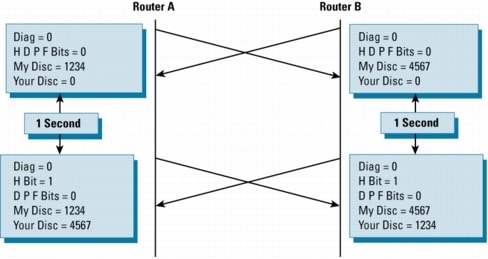- Cisco Community
- Technology and Support
- Networking
- SD-WAN and Cloud Networking
- What is LD/RD on bfd?
- Subscribe to RSS Feed
- Mark Topic as New
- Mark Topic as Read
- Float this Topic for Current User
- Bookmark
- Subscribe
- Mute
- Printer Friendly Page
What is LD/RD on bfd?
- Mark as New
- Bookmark
- Subscribe
- Mute
- Subscribe to RSS Feed
- Permalink
- Report Inappropriate Content
04-12-2020 10:03 PM
Hi All,
I am curious about explaination of LD/RD on BFD, Could someone explain it?
Any suggestion will be very appreciated, Thank you!
- Labels:
-
SD-WAN Security
- Mark as New
- Bookmark
- Subscribe
- Mute
- Subscribe to RSS Feed
- Permalink
- Report Inappropriate Content
04-13-2020 07:53 PM
Hello,
bfd.LocalDiscr :-
The local discriminator for this BFD session, used to uniquely
identify it. It MUST be unique across all BFD sessions on this
system, and nonzero. It SHOULD be set to a random (but still
unique) value to improve security. The value is otherwise outside
the scope of this specification.
bfd.RemoteDiscr :-
The remote discriminator for this BFD session. This is the
discriminator chosen by the remote system, and is totally opaque
to the local system. This MUST be initialized to zero. If a
period of a Detection Time passes without the receipt of a valid,
authenticated BFD packet from the remote system, this variable
MUST be set to zero.
Please mark as a solve and hit helpful button, if you got your answer.
Regrads,
Rohit Raj
Rohit Raj
- Mark as New
- Bookmark
- Subscribe
- Mute
- Subscribe to RSS Feed
- Permalink
- Report Inappropriate Content
04-13-2020 09:27 PM
Hi Rohit,
Thanks for your explaination, Where I can find this explaination? URL, docs or blog maybe?
Best Regards,
Noffal
- Mark as New
- Bookmark
- Subscribe
- Mute
- Subscribe to RSS Feed
- Permalink
- Report Inappropriate Content
08-21-2020 10:53 AM

Discover and save your favorite ideas. Come back to expert answers, step-by-step guides, recent topics, and more.
New here? Get started with these tips. How to use Community New member guide

